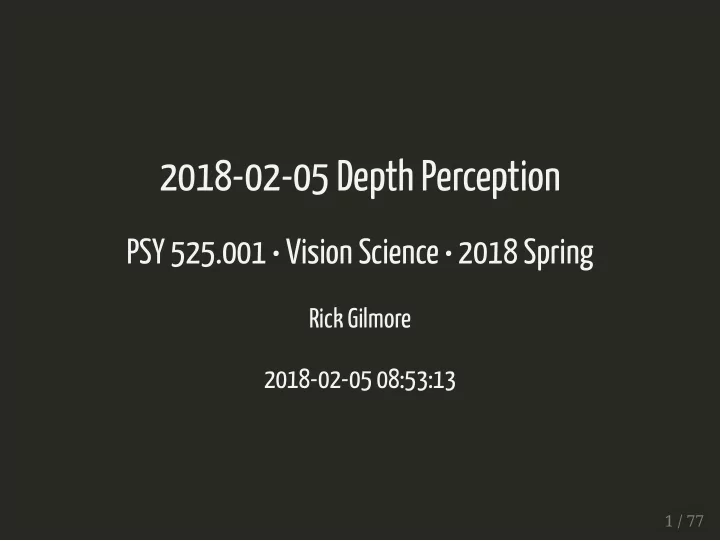

2018-02-05 Depth Perception PSY 525.001 • Vision Science • 2018 Spring Rick Gilmore 2018-02-05 08:53:13 1 / 77
2 / 77
But what is the Fourier Transform? A visual introduction. 3 / 77
Today's topics 4 / 77
Today's topics Discuss project proposal 4 / 77
Today's topics Discuss project proposal Depth perception 4 / 77
Today's topics Discuss project proposal Depth perception Discuss Leopold & Logothetis, N. K. (1996). 4 / 77
Term project 5 / 77
http://psu-psychology.github.io/psy-525-vision-spring-2018/project- proposal.html 6 / 77
Perceiving surfaces orientation (spatial layout) Slant, tilt, distance 7 / 77
8 / 77
Marr's 2.5 D sketch 9 / 77
10 / 77
Depth perception 11 / 77
"For those of a creationist bent, one could note that God must have loved depth cues, for He made so many of them" Yonas & Granrud, 1985, p. 45 12 / 77
Kinetic Binocular Static (pictoral) Sensorimotor 13 / 77
Monocular (kinetic, static, some sensorimotor) vs. binocular cues 14 / 77
Kinetic cues to depth 15 / 77
Kinetic Depth Effect Demo Kinetic depth e�ect (KDE) 16 / 77
By Nobuyuki Kayahara - Procreo Flash Design Laboratory, CC BY-SA 3.0, Link This one is also bistable 17 / 77
Kinetic depth e�ect 3D structure perceived from temporal sequence of 2D (outline-only) views. Reported in Wallach, H., & O’Connell, D. N. (1953). The Kinetic Depth Effect. Journal of Experimental Psychology , 45 (4), 205. 18 / 77
Structure from Motion Demo Structure from motion 19 / 77
Archival Gibson - 1958 - Motion parallax and perceived depth Motion parallax 20 / 77
City motion parallax 21 / 77
The geometry of motion parallax Where is fixation? What is the direction of motion? 22 / 77
PJ Treffner - Occlusion demos: Accretion and deletion Texture accretion & deletion 23 / 77
Second-order motion perception Texture accretion & deletion 24 / 77
Task 1: Example of 100% Radial Optic Flow (no random dots) wit… Optic �ow 25 / 77
AR.Drone Helicopter Optical Flow Test #1 Optic �ow and autonomous �ight 26 / 77
Binocular cues to depth 27 / 77
Stereopsis Perception of depth and 3D structure from stimulation of both eyes 28 / 77
Horopter a line or surface containing all those points in space whose images fall on corresponding points of the retinas of the two eyes. 29 / 77
30 / 77
Random-dot stereograms Invented by Béla Julesz 31 / 77
32 / 77
library (imager) n_pts <- 100 left_img <- array(round(runif(n=n_pts^2),0), dim = c(n_pts, n_pts)) plot(as.cimg(left_img), axes=FALSE) 33 / 77
right_img <- left_img square_pix <- 20 center_square <- right_img[floor(n_pts/2-square_pix/2):floor(n_pts/2+ plot(as.cimg(center_square), axes=FALSE) 34 / 77
Auto-stereogram Can't really fuse these from projected image. Why? 35 / 77
The "correspondence" problem How do retinal image points/edges correspond to object points/edges? Why can it take time to "fuse" stereograms? 36 / 77
37 / 77
Marr-Poggio algorithm for solving Use: surface opacity & surface continuity heuristics Iterate until a best-fitting solution is found 38 / 77
Da Vinci stereopsis Different eyes see different portions of surfaces 39 / 77
Geometry of self-motion, object-motion, and disparity 40 / 77
Static (pictoral) cues to depth 41 / 77
Linear Perspective 42 / 77
43 / 77
44 / 77
Public Domain, Link Linear perspective + elevation over horizon = Ponzo illusion 45 / 77
Relative size 46 / 77
47 / 77
48 / 77
Ames Room Illusion Ames room 49 / 77
Actual position of Person A Apparent position of person A Actual and apparent position of person B Apparent Viewing shape of room peephole https://en.wikipedia.org/wiki/Ames_room 50 / 77
Aerial perspective Defocus blur 51 / 77
By Joaquim Alves Gaspar - Own work, CC BY-SA 2.5, Link 52 / 77
Interposition, occultation 53 / 77
Texture gradients 54 / 77
By Gustave Caillebotte - 5wEUCOlEf-EaVQ at Google Cultural Institute maximum zoom level, Public Domain, Link 55 / 77
56 / 77
http://psychsciencenotes.blogspot.com/2011/08/mirrors-are-literally-windows- to.html 57 / 77
Lighting, shading, & shadow cues 58 / 77
59 / 77
60 / 77
61 / 77
Sensorimotor cues to depth Palmer's "ocular" cues 62 / 77
Vergence Eyes (typically) converge on a 3D point. Angle of vergence related to 3D geometry. 63 / 77
Lens Accommodation Accommodation 64 / 77
The accommodation re�ex < Vergence, pupil diameter change, + accommodation 65 / 77
2-Minute Neuroscience: Vestibular System Vestibular system detects head rotation, translation 66 / 77
Vestibular signals speed, direction of rotation, translation More motion parallax with head translation than rotation 67 / 77
Comparing the cues 68 / 77
The human brain in depth: how we see in 3D Integrating the cues Welchman, A. E. (2016). The human brain in depth: how we see in 3D. Annual Review of Vision Science . annualreviews.org. Retrieved from http://www.annualreviews.org/doi/abs/10.1146/annurev-vision-111815-114605 69 / 77
Heuristics About world, illumination conditions 70 / 77
Alternative view: These aren't cues; they are information. Animals don't "reconstruct" 3D space; they perceive it directly. 71 / 77
Amazing T-Rex Illusion! 72 / 77
Break time 73 / 77
Leopold & Logothetis, N. K. (1996) 74 / 77
Core phenomena Binocular rivalry Neural basis of binocular rivalry Neural basis of "conscious" visual experience 75 / 77
Next time... Perceptual organization Size, shape, orientation, & position 76 / 77
Slides created via the R package xaringan . Rendered HTML and supporting files are pushed to GitHub where GitHub's 'pages' feature is used to host and serve the course website. 77 / 77
Recommend
More recommend